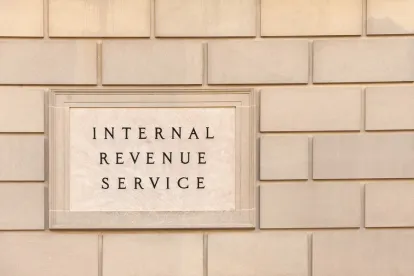The Internal Revenue Service (IRS) recently issued practical and helpful guidance in a question-and-answer format for tax-qualified retirement plans and for an Individual Retirement Arrangement (IRA), regarding the legislative changes under the Setting Every Community Up for Retirement Enhancement Act of 2019 (the “SECURE Act”) and the Bipartisan American Miners Act of 2019 (the “Miners Act”). Below are the most significant takeaways from this recent guidance.
In Depth
Part-time Employees
To begin participating in its tax-qualified retirement plan, an employer generally may require an employee to complete 1,000 hours of service during a 12-consecutive-month period. Under this rule, a long-term, part-time employee may be excluded from plan participation. Starting with plan years beginning on or after December 31, 2020, the SECURE Act requires employers to permit a long-term, part-time employee, who works at least 500 hours in three consecutive 12-month periods, to participate in a defined contribution plan that permits pre-tax salary deferral contributions (other than collectively bargained plans). The SECURE Act also added a special vesting rule, which provides that a long-term, part-time employee must be credited with a year of vesting service for each 12-month period during which the employee completes at least 500 hours of service. However, an employer is not required to make matching or nonelective contributions on behalf of such an employee and may continue to impose an age-21 eligibility requirement.
In applying the special vesting rule under the SECURE Act, if the long-term part-time employee has at least 500 hours of service, then each 12-month period must be credited as a year of vesting service. Unlike the expanded eligibility rule, periods prior to January 1, 2021, are counted for determining vesting service (unless excluded by some other exception). For example, if a part-time employee works 500 or more hours in 2019 and 2020, and if this employee becomes a full-time employee in 2021 and eligible for employer matching or nonelective contributions, then the employee’s service in 2019 and 2020 will count in determining vesting service. Due to the potentially burdensome nature of this requirement for employers that may not have counted hours prior to 2021, the IRS has asked for additional public comment on how to reduce the administrative burden in calculating and crediting prior years of service.
Withdrawals for Birth or Adoption
Beginning for plan years that start on or after December 31, 2019, the SECURE Act allows penalty-free withdrawals of up to $5,000 from certain defined contribution plans, if the participant receives the withdrawal within 12 months of the birth of a child or adoption of an eligible adoptee. However, such withdrawals are subject to normal income taxes. Under certain conditions, the participant may repay this withdrawal, or the participant may re-contribute the withdrawn amount to another tax-qualified retirement plan.
The new guidance answered common questions about qualified birth or adoption distributions (QBADs):
-
A QBAD may be made from eligible retirement plans, including 401(k), 403(b) and 457(b) governmental plans or an IRA.
-
An eligible adoptee is an individual who has not attained age 18 or is physically or mentally incapable of self-support, not including children of a taxpayer’s spouse.
-
Each parent may receive a QBAD up to $5,000 with respect to the same child or adoptee. An individual is also permitted to receive a QBAD for the birth of more than one child or adoption of more than one adoptee in the same 1-year period (g., the birth of twins would allow a $10,000 distribution to each parent).
-
Plan sponsors and administrators may rely on a participant’s reasonable representation that the individual is eligible for a QBAD, absent actual knowledge to the contrary.
-
If an employer permits a QBAD, it must also accept a re-contribution of the QBAD (assuming the individual is otherwise eligible to make a rollover contribution to that plan). If the re-contribution is within 60 days, it will be treated as a direct transfer of an eligible rollover contribution.
-
A QBAD is not treated as an eligible rollover distribution for purposes of the direct rollover rules and the mandatory 20 percent withholding does not apply.
Tax Credit for Small Employers
The SECURE Act added a new $500 business tax credit for eligible small employers (generally, those with fewer than 100 employees) who amend an existing plan or include in a new plan an eligible automatic enrollment arrangement (EACA). The credit is available for a single three-year credit period, beginning in 2020 for each taxable year that the EACA is included in the retirement plan.
The Notice clarified that the three-year credit period begins when the employer first includes an EACA in any retirement plan. The EACA must then be included in the same plan for the second and third years for the credit to be available. An employer that sponsors more than one plan with an EACA will not receive more than one credit (the credit applies only to the employer and not the plan itself).
The Notice also confirmed the credit applies to an eligible employer who participates in a multiple-employer plan (MEP) in the same way it would if the employer sponsored a single-employer plan. Each employer is entitled to a credit for the three-year period, beginning with the first taxable year in which the employer’s participating employees were first covered by an EACA under the MEP. A single-employer plan that is spun-off from an MEP (and that continues to include an EACA in subsequent years) could also receive the credit.
IRA Contributions After Age 70½
The SECURE Act repealed Code section 219(d)(1), which previously prevented individuals from making contributions to their traditional IRA for a tax year if the individual attained age 70½ by the last day of such tax year. The new guidance clarifies that a financial institution does not have to accept post-age 70½ contributions beginning after December 31, 2019. If the financial institution chooses to accept such contributions, it must amend its IRA contracts and distribute a copy of the amendment and a new disclosure statement to each IRA individual not later than the 30th day after the date on which the amendment is adopted, or the date the amendment becomes effective, whichever is later.
Minimum Age for in-service Distributions
For plan years beginning after December 31, 2019, the Miners Act lowered the minimum age for allowable in-service distributions from 62 to 59½ for defined benefit pension plans, and from age 70½ to 59½ for Code section 457(b) plans. Neither of these plans is required to provide in-service distributions. Even if in-service distributions are permitted, employers are not required to amend their plans to allow in-service distributions at age 59½. Further, any change to in-service distributions is separate from the definitely determinable benefit requirement—plans are free to change the definition of normal retirement age as long as the plan continues to satisfy all the other legal requirements.
Conclusion
The deadline to amend a tax-qualified retirement plan for SECURE Act and Miners Act changes is the last day of the plan year beginning on or after January 1, 2022 (or, on or after January 1, 2024, for qualified government plans or collectively bargained plans). In the meantime, plan sponsors and administrators must operate their retirement plans in compliance with SECURE Act and Minor Act requirements, based on the effective dates of each applicable provision and this new guidance.
Teal Trujillo, a law clerk in our Chicago office, also contributed to this On the Subject.





 />i
/>i


